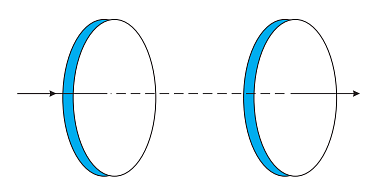Question
Physics Question on Electromagnetic Waves
Figure shows a capacitor made of two circular plates each of radius 12 cm, and separated by 5.0 cm. The capacitor is being charged by an external source (not shown in the figure). The charging current is constant and equal to 0.15 A.
- Calculate the capacitance and the rate of charge of potential difference between the plates.
- Obtain the displacement current across the plates.
- Is Kirchhoff’s first rule (junction rule) valid at each plate of the capacitor? Explain.

Radius of each circular plate, r=12 cm=0.12 m
Distance between the plates, d=5 cm=0.05 m
Charging current, I=0.15 A
Permittivity of free space, ε0=8.85×10−12C2N−1m−2
(a) Capacitance between the two plates is given by the relation,
c=dε0A
Where,
A = Area of each plate = πr2
C=dε0πr2
C=0.058.85×10−12×3.14×(0.12)2
C=8.0032×10−12F
C=80.032 pF
Charge on each plate, q=CV
Where,
V = Potential difference across the plates
Differentiation on both sides with respect to time (t) gives:
dtdq=CdtdV
But, dtdq = Current (I)
dtdV=CI
dtdV=80.032×10−120.15
dtdV= 1.87×109 V/s
Therefore, the change in potential difference between the plates is 1.87×109 V/s.
(b) The displacement current across the plates is the same as the conduction current. Hence, the displacement current, id is 0.15 A.
(c) Yes
Kirchhoff’s first rule is valid at each plate of the capacitor provided that we take the sum of conduction and displacement for current.
